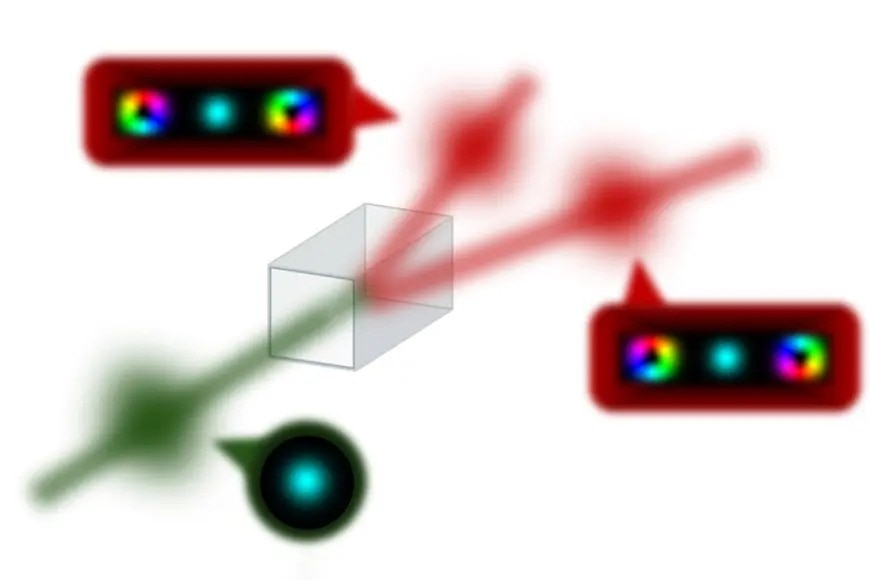
For the first time, scientists split a single photon (green) into two photons (red) and conserved angular momentum. (Image Credit: Robert Fickler/Tampere University)
Scientists at Tampere University split a single photon into two, demonstrating that it still has angular momentum. Their experiment verifies a fundamental aspect of quantum physics and paves the way toward engineering advanced quantum states for sensing, computing, and communication applications.
Conservation laws define possible processes in science. For instance, this occurs in the angular momentum of spinning objects and momentum transfer in billiard collisions. Even light has angular momentum—orbital angular momentum (OAM), based on the shape of its beam. Photons have definite amounts of OAM that need to be conserved in interactions. The team tested this principle in their study, determining whether OAM is preserved at the quantum scale after splitting a photon into two.
According to the conservation law, a photon with zero OAM splitting into two must have the resulting photons carry opposite values that balance each other. Laser-based optics experiments verified that rule, and it hasn't been tested with just one photon before.
The team used spontaneous parametric down-conversion (SPDC), a quantum optical process that converts a photon into a pair of photons with its OAM conserved. Instead of relying on waveguide-based systems, the setup used bulk nonlinear optical crystals for the free-space interaction of photons. A single photon with a well-defined OAM produced by precise lasers and spatial light modulators served as the pump photon for the down-conversion. A periodically poled nonlinear crystal enabled SPDC, converting the pump photon into two photons that carry a similar OAM value as the original photon. This ensures angular momentum is conserved.
The researchers also deployed a beam splitter, spatial mode analyzers, and mode sorters for photon spatial mode and OAM analysis. These tools manipulate and characterize the photons’ twisted wavefronts—practical for measuring the OAM value associated with the generated photons. Doing so ensured that the OAM quantum numbers were consistent, proving conservation.
They used superconducting nanowire single-photon detectors (SNSPDs) to measure the heralding photons. SNSPDs are ultra-sensitive with very low dark counts, helping to identify down-conversion even in background noise. This experiment required high efficiency and low dark-count detection since photon spotting is very rare. Additionally, they relied on coincidence counting techniques to correlate detection events of the paired photons, which helped verify that the pair came from splitting the original single photon. Coincidence counting is essential as one in a billion photons undergoes down conversion.
The experiment also required stability and low background noise since measurements ran for days to collect data. With this run-time, the team precisely verified the fundamental quantum conservation law and proved quantum entanglement in the photon pairs created by the single-photon pump.
Next, the team plans to make the setup more efficient and easier to measure the generated quantum state. Additionally, the team wants to use the generated multi-photon quantum states for quantum tests and quantum photonics applications like quantum communication and network schemes.
Have a story tip? Message me at: http://twitter.com/Cabe_Atwell

-

DAB
-
Cancel
-
Vote Up
0
Vote Down
-
-
Sign in to reply
-
More
-
Cancel
Comment-

DAB
-
Cancel
-
Vote Up
0
Vote Down
-
-
Sign in to reply
-
More
-
Cancel
Children